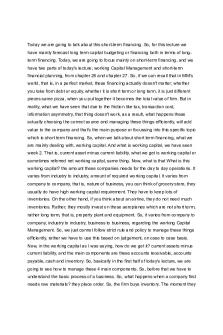Lesson 8 - Lecture notes 8 PDF

| Title | Lesson 8 - Lecture notes 8 |
|---|---|
| Author | Brittany Preston |
| Course | History of Rock and Roll |
| Institution | Grand Valley State University |
| Pages | 19 |
| File Size | 909.9 KB |
| File Type | |
| Total Downloads | 22 |
| Total Views | 183 |
Summary
William Ryan...
Description
Introduction
Frankie Avalon
The face of rock and roll music began to change in the early 1960s. The payola scandal effectively ended Alan Freed’s career, along with many other disc jockeys who had promoted rock and roll in the 1950s. With the rise of shows such as American Bandstand and the promotion of pop-oriented artists such as Frankie Avalon, Fabian Forte, Bobby Vee, and Leslie Gore, rock had changed from a forbidden fruit to an everyday commodity. Studios were cranking out songs in mass quantities that were then attached to teen idol singers who had been molded by a recorded label into an ideal pop star.
Fabian Forte
Major record labels faced a serious problem at the end of the 1950s. Throughout the decade, they had considered rock and roll to be trashy, nothing more than a passing fad that would eventually go away on its own. Since major labels did not pick up many rock and roll artists, most musicians recorded on independent labels. As rock and roll exploded into the mainstream and many of the pop hits were in the rock and roll genre, the major record labels recognized their error. Now, the tiny independent labels were cashing in on the success of these rock and roll artists, which posed a serious threat to the commercial success and viability of major labels. Thus, the major labels attempted to reclaim control from the indie labels, and they accomplished this by means of the payola scandal.
“ Rock and roll itself can be described as music to accompany the rite of passage.” -Pete Townshend
“Rock and roll is - and should be - a kid's place.” -Ben Folds
By 1962 the Brill Building contained 165 music businesses, and was a classic model of vertical integration. The History of Rock 'n' Roll
Payola Musicians had resorted to all sorts of tactics to get their music played, going as far back as bribing vaudeville singers with cigars, liquor, and song-writing credits to perform the latest Tin Pan Alley song on their traveling circuit. Bribery and special favors were nothing new in the history of popular music. Recall that Alan Freed had promoted Chuck Berry’s "Maybellene ♫" in exchange for a credit as co-author of the song. In order to crack down on independent labels and disc jockeys, however, the major labels
went after them for engaging in these practices, which were known as payola. The payola scandal occurred when major record labels went after the disc jockeys and the independent labels in such a way that drew the attention of a congressional committee and, eventually, the Federal Trade Commission (FTC) and the Federal Communications Commission (FCC). As a result, many disc jockeys lost their jobs, including Alan Freed. Radio stations were forced to revise their programming in order to keep their FCC broadcasting licenses. The payola scandal cast rock and roll as a trashy music whose popularity only came as the result of independent labels that bribed greedy disc jockeys to play the music on-air. American youth were victims of underhanded marketing ploys and dirty deals concocted between record labels and disc jockeys. From the point of view of independent record labels, disc jockeys, and recording artists, they were promoting their music using the same means that had been used for over half a century. It is worth nothing here that it is not illegal for a disc jockey to accept gifts, money, or songwriting credits in exchange for playing a particular record. However, the disc jockeys were required by law to declare those gifts on their income taxes, which most of them did not. They were also supposed to state on-air that they had received compensation for promoting the music. Convicted of accepting bribes and fired from his radio and television shows, Alan Freed was the most notable victim of the payola scandal. Eventually, a bill was passed that made payola illegal. As a result, radio stations were subjected to very strict supervision, which then made it much easier to control the distribution of popular music that was played and heard. Many radio stations began playing as few black artists as possible in order to remain in good graces with the
FCC. Having wrested power away from disc jockeys and independent labels, the music executives of the major labels now needed to find a way to reach the teenage market that had developed an appetite for rock and roll.
“Rock and roll is - and should be - a kid's place.” -Ben Folds
“The whole American pop culture started in Philadelphia with 'American Bandstand' and the music that came out of that city.” -Daryl Hall
By 1962 the Brill Building contained 165 music businesses, and was a classic model of vertical integration.
The History of Rock 'n' Roll
American Bandstand
Dick Clark
After several modest jobs in radio and television, Dick Clark got his big break. He took over Bob Horn's Bandstand, changed the name to American Bandstand, and did his first big program on August 5, 1957. The show aired for 90 minutes each weekday afternoon and on Monday nights from 7:30 to 8:00 p.m. These were ideal times for a teenage viewing audience that could be counted on to turn the program on as soon as they got home from school each afternoon. On the program, one hundred fifty teenagers were in the audience, many of them getting up to dance and to offer their opinions about the music. With his smooth patter and impeccable good taste, Clark
would mingle with the members of the teenage audience, and he would then interview several guest musical artists before they got up to lip-sync their most recent hits. The performers lip-synced instead of performing live in order to prevent any unpredictable behavior or spontaneity during the performance. There would be no shenanigans like Elvis’s electrified hips on The Milton Berle Show or Jerry Lee Lewis throwing his piano bench on The Steve Allen Show. For many of the performers on the show, lip-syncing was also preferable to a live performance because the majority of these performers were not strong singers. Instead, they were chosen for their good looks and wholesome appeal and then turned into pop stars by major record labels. This point will be elaborated later in this lesson. Clark’s business savvy transformed a local telecast into a national phenomenon. To get sponsors for the show, he traveled the advertising agency circuit on Madison Avenue and eventually acquired the lucrative Beechnut Spearmint Gum account. In no time at all, Clark became famous and very wealthy. He was one of the most influential disc jockeys in the nation. Clark was never accused of taking payola, but his business connections were scrutinized. He had controlling interest in six publishing companies, held over 160 copyrights, and owned four record labels (Swan, Chancellor, Cameo-Parkway, and Jamie Records). He also owned a record pressing plant, the Chip Record Distribution Corporation, an artist management firm, the touring Dick Clark’s Caravan of Stars, and a concert format of the live broadcast that was called The Dick Clark Show—33 corporations, in all. Clark was a shrewd businessman. For example, he had no financial interest in the Luther Dixon’s song "Sixteen Candles ♫" as recorded by The Crests, and he therefore played the song only four times in ten weeks on American Bandstand. After he purchased the company that published "Sixteen
Candles ♫," though, he played it 27 times in thirteen weeks. Shortly before the payola hearings, he divested himself of 31 of his 33 companies, and then he re-purchased those same companies later when the hearings were done.
American Bandstand
For nearly ten years, American Bandstand was a primary force in the creation of a whole outlook on teenage life— hairstyles, clothes fashions, dating issues, and all the other adolescent concerns about behavior and social values. More important than any other aspect of teenage culture, though, was American Bandstand’semphasis on dancing. The rock and roll music of the 1950s was focused on the performer and the performance rather than dancing to the music that was being performed. American Bandstand changed that outlook, putting primary importance on being able to dance along with a song. Chubby Checker’s song "The Twist ♫" reached number 1 on the pop charts twice, first in 1960 and again in 1962. A cover version of a rhythm and blues song that was originally recorded by Hank Ballard and the Midnighters, "The Twist ♫" was the first and most important of many dance crazes that swept the United States during the early 1960s. "The Twist ♫" was so popular, in fact, that it was the best-selling single of all time until the 1970s. "The Twist"
inspired dozens of other dance songs during the 1960s: "Peppermint Twist ♫," "The Loco-Motion ♫," "(Do the) Mashed Potato ♫," "The Wah-Watusi ♫," "The Fish," "The Fly," "Do The Bird ♫," "The Hucklebuck ♫," "The Limbo Rock ♫," and "Pony Time ♫" were just a few. Perhaps most importantly, "The Twist ♫" introduced audiences to the idea of open or solo dancing, in which the dancers never came into physical contact with each other. Open dancing was yet another way to remove any notions of sexuality from this new brand of rock music because the dancers never touched each other. Dick Clark launched the careers of Fabian Forte, Frankie Avalon, Bobby Rydell, the Dovells, and Chubby Checker. It is important to note that, of all of the singers who Clark promoted on American Bandstand in the late 1950s and early 1960s, Chubby Checker was the only black artist who appeared with any regularity. All of the other acts were white. American Bandstand was on the air for over thirty years, but by 1964, it aired only once a week and no longer held the same place as a cultural phenomenon that it had in the late 1950s and early 1960s. Often called "America’s oldest living teenager," Dick Clark gave rock and roll a wholesome image and helped promote the latest singing sensation, the teen idol.
“Dick Clark's 'American Bandstand' spread the gospel of American pop music and teenage style that transcended the regional boundaries of our country and united a youth culture that eventually spread its message throughout the entire world.” -John Oates
“ Rock and roll itself can be described as music to accompany the rite of passage.” -Pete Townshend
By 1962 the Brill Building contained 165 music businesses, and was a classic model of vertical integration. The History of Rock 'n' Roll
The Teen Idol
Chubby Checker
Another way in which major record companies attempted to control the teen listening market was by developing the teen idol. Teen idols were white, clean-cut, well-mannered, and polite. The girls were wholesome and sweet, and the boys promised to have you home by ten o’clock with nothing more than a kiss on the cheek. The early 1960s saw the rise of what has been called schlock rock or bubblegum pop, that is, bland songs by white artists about noncontroversial topics such as romantic love. Of all of these artists, Chubby Checker was the single black artist who achieved success in the bubblegum pop or schlock rock genre. For the most part, the music recorded by teen idols lacked the raw edge and sexual energy that had characterized the rock and roll music of the 1950s. Fiery Jerry Lee Lewis- or Little Richard-styled piano solos were replaced with swooning orchestral arrangements. Playful lyrics filled with double entendres fell away in favor of topics of teenage love and devotion. The teen icons of this era were far less threatening to parents than 1950s icons such as Elvis Presley, Chuck Berry, or even Buddy Holly. Handsome and sweet, singers like Frankie Avalon, Bobby Vee, Fabian Forte, and Bobby Vinton topped the charts with their songs
about heartbreak and romantic love. In fact, many of these teen idol stars were not particularly musically gifted. It was common practice at the time for a record label to find a good-looking young man who could carry a tune reasonably well and then transform him into a star. Labels such as Chancellor, Swan, and Cameo-Parkway would spend weeks or months polishing these boys next door for their big pop debuts.
Carole King
Bobby Vee’s "Take Good Care of My Baby ♫" is a classic example of the teen idol pop song of the early 1960s. Written by the husbandand-wife songwriting duo of Carole King and Gerry Goffin, "Take Good Care of My Baby ♫" is a sweet-as-sugar message to the new boyfriend of a former love. Unlike other pop icons of the era such as Frankie Avalon and Fabian Forte, Bobby Vee did have a musical background. He idolized Buddy Holly, and his band even filled in for Buddy Holly and the Crickets when Holly was killed in a plane crash. However, once Liberty Records signed him 1960, Vee was quickly transformed from a guitar-wielding Buddy Holly wannabe into a teen idol pop star. Although most of the teen idol stars of this era were male, a few
female artists found a modicum of success with the Brill Building formula, including Connie Francis, Annette Funicello, Leslie Gore, and Little Peggy March. Their songs, like those of their male counterparts, were largely about love, loyalty, and heartbreak, with minimal references to any physical expressions of love. As we will see in the next lesson, Brill Building songwriting particularly benefited African American girl groups, much more so than white solo female artists.
“The whole American pop culture started in Philadelphia with 'American Bandstand' and the music that came out of that city.” -Daryl Hall
“The '60s was a magical time in the music business. So much creativity and talent. I think a lot of it came from the fact that we had grown up before rock n' roll. We listened to all the great songwriters and big bands, songs with great lyrics and melodies. I think that really influenced everybody.” -Frankie Valli
Teenage studio guests of American Bandstand could rate records on a scale from 25 to 98. Daily Beast
Brill Building
Brill Building
Songwriter Don Kirshner wanted to create a haven for and hub of rock songwriters much in the way that popular songwriters had gathered in the days of Tin Pan Alley. At age 24, Kirshner and pop guitarist Al Nevins of the Three Suns formed Aldon Music in 1958.
They rented offices across the street and up a few doors from the famous Brill Building (1619 Broadway at 49th) where the Tin Pan Alley publishers had worked for so many years. Kirshner and Nevins created a world of "publisher-manufactured" style of rock and roll by combining the tastes of rock and roll with Tin Pan Alley-like songwriting teams. Rock industry insiders began to call the tunes "Brill Building rock," after the place where the music was produced. The formula for a Brill Building song was methodical, precise, and completed without any specific recording artist in mind. The songwriters hardly ever performed their own compositions during the 1960s. (A few of the Brill Building songwriters such as Neil Sedaka, Paul Anka, and Carole King did go on to have their own successful recording careers, though.) Instead, record companies would place orders for teen idol songs that could be customized to meet the demands of the listening audience. At his peak, Don Kirshner had 35 songwriters working for Aldon Publishing. Journalists said that Tin Pan Alley had become "Teen Pan Alley."
Carole King and Gerry Goffin
The Brill Building style and practice included many composer-lyricist teams, three of which are particularly notable. Neil Sedaka and
Howie Greenfield produced dozens of pop tunes, such as "Calendar Girl ♫" and "Breaking Up Is Hard To Do ♫." Composer Barry Mann and his wife, lyricist Cynthia Weil, were a particularly prolific duo. Mann and Weil wrote tunes 9 a.m. to 5 p.m. just like factory workers , including "Walking In the Rain ♫" for the Ronettes and "On Broadway ♫" for the Drifters. Another husband-and-wife team, Carole King and Gerry Goffin, also turned out a wide variety of hits: "Will You Love Me Tomorrow? ♫" (The Shirelles), "Take Good Care of My Baby ♫" (Bobby Vee), "The Loco-Motion ♫" (Little Eva), "Halfway to Paradise ♫" (Tony Orlando and Bobby Vinton), to name a few. A surprising number of these songwriting duos consisted of husband-and-wife teams such as King and Goffin and Mann and Weil, which meant that the Brill Building songwriting approach included many more women than did earlier songwriting such as that of Tin Pan Alley and Broadway. As we will see in the following lesson, the Brill Building formula provided many hit tunes not only for teen idol pop stars but also for African American girl groups such as the Crystals and the Ronettes.
“Dick Clark's 'American Bandstand' spread the gospel of American pop music and teenage style that transcended the regional boundaries of our country and united a youth culture that eventually spread its message throughout the entire world.” -John Oates
“Rock and roll is - and should be - a kid's place.” -Ben Folds
Teenage studio guests of American Bandstand could rate records on a scale from 25 to 98. Daily Beast
Conclusion
Frankie Avalon
As we saw in this lesson, the major record labels took back control from radio disc jockeys and independent record labels. Through the payola scandal, Alan Freed’s career was ruined. American Bandstand soon became the primary source for teenage listeners to hear the newest hits. The 1960s also saw the rise of teen pop idols such as Frankie Avalon, Bobby Vee, and Fabian Forte. Don Kirshner and his many songwriters produced hit after hit in a formula that became known as the Brill Building, after the place where the music was written. In the next lesson, we will look at other types of popular music from the early 1960s that was marketed toward a teen audience.
“The '60s was a magical time in the music business. So much creativity and talent. I think a lot of it came from the fact that we had grown up before rock n' roll. We listened to all the great songwriters and big bands, songs with great lyrics and melodies. I think that really influenced everybody.” -Frankie Valli
“Teenagers did not have, before rock 'n' roll and rhythm-and-blues - they did not have any type of music they could call their own once they got over 4 or 5 years old until they were well into their 20's and considered adults.” -Sam Phillips
Teenage studio guests of American Bandstand could rate records on a scale from 25 to 98. Daily Beast...
Similar Free PDFs

Lesson 8 - Lecture notes 8
- 2 Pages

Lesson 8 - Lecture notes 8
- 19 Pages

8 - Lecture notes 8
- 21 Pages

8 - Lecture notes 8
- 21 Pages

Lesson 8 - NOTES
- 7 Pages

8 Midwifery - Lecture notes 8
- 3 Pages

Taxation 8 - Lecture notes 8
- 2 Pages

Week 8 - Lecture notes 8
- 6 Pages

Dox 8 - Lecture notes 8
- 21 Pages

Assignment 8 - Lecture notes 8
- 4 Pages

Week 8 - Lecture notes 8
- 23 Pages

WEEK 8 - Lecture notes 8
- 10 Pages

CL-8 - Lecture notes 8
- 12 Pages

Tema 8 - Lecture notes 8
- 8 Pages

Chapter 8 - Lecture notes 8
- 7 Pages

Chapter 8 - Lecture notes 8
- 2 Pages
Popular Institutions
- Tinajero National High School - Annex
- Politeknik Caltex Riau
- Yokohama City University
- SGT University
- University of Al-Qadisiyah
- Divine Word College of Vigan
- Techniek College Rotterdam
- Universidade de Santiago
- Universiti Teknologi MARA Cawangan Johor Kampus Pasir Gudang
- Poltekkes Kemenkes Yogyakarta
- Baguio City National High School
- Colegio san marcos
- preparatoria uno
- Centro de Bachillerato Tecnológico Industrial y de Servicios No. 107
- Dalian Maritime University
- Quang Trung Secondary School
- Colegio Tecnológico en Informática
- Corporación Regional de Educación Superior
- Grupo CEDVA
- Dar Al Uloom University
- Centro de Estudios Preuniversitarios de la Universidad Nacional de Ingeniería
- 上智大学
- Aakash International School, Nuna Majara
- San Felipe Neri Catholic School
- Kang Chiao International School - New Taipei City
- Misamis Occidental National High School
- Institución Educativa Escuela Normal Juan Ladrilleros
- Kolehiyo ng Pantukan
- Batanes State College
- Instituto Continental
- Sekolah Menengah Kejuruan Kesehatan Kaltara (Tarakan)
- Colegio de La Inmaculada Concepcion - Cebu